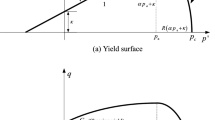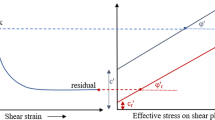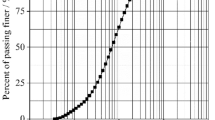Abstract
An understanding of the creep behavior of clayey rocks is considered fundamental for further development in the fields of nuclear waste underground disposal, underground mine design, strata control, and many other geological phenomena occurring in the earth’s crust. In this research, we performed a series of long-term triaxial compressive tests on a typical clayey rock, which confirmed its high creep potential beyond the creep threshold. Further analysis of the creep mechanism of this clayey rock indicated that two effects—strengthening and damage—are accompanied by the creep process. Additionally, based on the overstress theory and Drucker–Prager cap model, we developed a novel constitutive model considering two creep reference surfaces—cohesion and consolidation. Meanwhile, laws to reflect the strength and damage effect during creep were established and applied to the above constitutive model. Finally, the above theoretical studies were implemented in the finite element method software ABAQUS FEA using the subroutines CREEP and USDFLD. Some theory parameters were verified through back analysis. A comparison between the experimental results and numerical simulations confirmed the superiority of the established theoretical model.
Highlights
-
Clayey rock exhibits high creep potential beyond the creep threshold.
-
Two effects—strengthening and damage—are accompanied by the creep process.
-
A novel creep constitutive model was established.
-
Strengthening and damage laws during creep were developed.
-
Model numerical implementation and parameters determination.










Similar content being viewed by others
References
Arulanandan K, Shen CK, Young RB (1972) Discussion: Undrained creep behaviour of a coastal organic silty clay. Géotechnique 22(3):536–537
Baldi G, Hueckel T, Peano A, Pellegrini R (1991) Developments in modelling of thermohydro-geomechanical behaviour of Boom Clay and clay-based buffer materials (volume 2) (No. EUR-13365/2). Commission of the European Communities
Blümling P, Bernier F, Lebon Pm Martin CD (2007) The excavation damaged zone in clay formations time-dependent behaviour and influence on performance assessment. Phys Chem Earth 32(8–14):588–599
Bonini M, Barla G, Barla M (2003) Characterisation studies of Tectonised Clay Shales and implications in the excavation of large size tunnels[C]//ISRM 2003–Technology roadmap for rock mechanics, South African Institute of Mining and Metallurgy
Chang CD, Zoback MD (2009) Viscous creep in room-dried unconsolidated Gulf of Mexico shale (I): experimental results. J Pet Sci Eng 69:239–246
Chang CD, Zoback MD (2010) Viscous creep in room-dried unconsolidated Gulf of Mexico shale (II): Development of a viscoplasticity model. J Pet Sci Eng 72(1–2):50–55
Desbois G, Höhne N, Urai JL, Bésuelle P, Viggiani G (2017) Deformation in cemented mudrock (Callovo-Oxfordian Clay) by microcracking, granular flow and phyllosilicate plasticity: insights from triaxial deformation, broad ion beam polishing and scanning electron microscopy. Solid Earth 8(2):291–305
Fabre G, Pellet F (2006) Creep and time-dependent damage in argillaceous rocks. Int J Rock Mech Min 43(6):950–960
François B, Collin F (2017) Anisotropic modelling of Opalinus Clay behaviour: from triaxial tests to gallery excavation application. J Rock Mech Geotech 9(3):435–448
François B, Collin F, Dizier A, Charlier R (2011) An extended Drucker-Prager hardening model for cross-anisotropy of soft rocks. In: Proceedings of the 15th European Conference on Soil Mechanics and Geotechnical Engineering, pp 537–540
Gasc-Barbier M, Chanchole S, Bérest P (2004) Creep behavior of Bure clayey rock. Appl Clay Sci 26(1–4):449–458
Giraud A, Rousset G (1996) Time-dependent behaviour of deep clays. Eng Geol 41:181–195
Griggs DT (1939) Creep of rocks. J Geol 47:225–251
Haghighat E, Rassouli FS, Zoback MD, Juanes R (2020) A viscoplastic model of creep in shale. Geophysics 85(3):155–166
Jia SP (2009) Hydro-mechanical coupled creep damage constitutive model of Boom clay, back analysis of model parameters and its engineering application. Institute of Rock and Soil Mechanics, Chinese Academy of Sciences, Wuhan
Jiang JH, Ling HI, Kaliakin VN (2017) On a damage law for creep rupture of clays with accumulated inelastic deviatoric strain as a damage measure. Mech Res Commun 83:22–26
Kaliakin VN, Dafalias YF (1990) Theoretical aspects of the elastoplastic-viscoplastic bounding surface model for cohesive soils. Soils Found 30(3):11–24
Kupferschmied N, Wild KM, Amann F, Nussbaum Ch, Jaeggi D, Badertscher N (2015) Time-dependent fracture formation around a borehole in a clay shale. Int J Rock Mech Min 77:105–114
Kutter BL, Sathialingam N (1992) Elastic-viscoplastic modelling of the rate-dependent behaviour of clays. Geotechnique 42(3):427–441
Lai XL, Wang SM, Ye WM, Cui YJ (2014) Experimental investigation on the creep behavior of an unsaturated clay. Can Geotech J 51(6):621–628
Li J, Yang Y (2018) Creep behavior of unsaturated reticulate red clay under matric suction. KSCE J Civ Eng 22:582–587
Liu ZB, Xie SY, Shao JF, Conil N (2015) Effects of deviatoric stress and structural anisotropy on compressive creep behavior of a clayey rock. Appl Clay Sci 114:491–496
Modaressi H, Laloui L (1997) A thermo-viscoplastic constitutive model for clays. Int J Numer Anal Met 21(5):313–335
Naumann M, Hunsche U, Schulze O (2007) Experimental investigations on anisotropy in dilatancy, failure and creep of Opalinus Clay. Phys Chem Earth 32:889–895
Neerdael B, De Bruyn D, Mair RJ, Taylor RN (1999) Geotechnical behavior of Boom Clay. Commission of the European Communities, Nuclear Science and Technology, Pilot tests on radioactive waste disposal in underground facilities, EUR 13985EN, pp 223–238
Perzyna P (1966) Fundamental problems in viscoplasticity. Adv Appl Mech 9:243
Perzyna P (1971) Thermodynamic theory of viscoplasticity. Adv Appl Mech 11:313–354
Pusch R (1979) Creep mechanisms in clay. Mechanisms of Deformation and Fracture, Pergamon. In: Proceedings of the Interdisciplinary Conference held at the University of Luleå, Luleå, Sweden, September 20–22, 1978, pp 351-359
Pusch R, Knutsson S, Liu Xd, Yang T (2016) Creep can strengthen clay: a matter of long-term slope stability. J Earth Sci Geotech Eng 6(1):1–18
Robinet JC, Sardini P, Coelho D, Parneix JC, Prêt D, Sammartino S, Boller E, Altmann S (2012) Effects of mineral distribution at mesoscopic scale on solute diffusion in a clay-rich rock: example of the Callovo-Oxfordian mudstone (Bure, France). Water Resour Res 48:W05554
Shi X, Yang X, Yue W, Yang L, Gui J, Huang H, Jiang S (2022) Experimental investigation on the creep behaviors of shale using nanoindentation technique and fractional constitutive models. J Pet Sci Eng. https://doi.org/10.1016/j.petrol.2022.110520
Tang AM, Cui YJ, Tali B, Doan DH (2008) Etude du comportement thermo-hydro-mécanique visqueux de l’argile de Boom[R]. École des Ponts Paris Tech, Paris
Van Asch Th WJ (1984) Creep processes in landslides. Earth Surf Proc Land 9(6):573–583
Vu M, Souley M, Alonso M, Vaunat J, Gens Solé A, Plúa C, de Lesquen C, Armand G (2021) Creep effects on the thermo-hydro-mechanical responses of Callovo-Oxfordian claystone. In: A: "Challenges and Innovations in Geomechanics: Proceedings of the 16th International Conference of IACMAG". Berlín: Springer, pp 663–671
Wang H, Jiang C, Zheng PQ, Li N, Zhan YB (2020) Deformation and failure mechanism of surrounding rocks in crossed-roadway and its support strategy. Eng Fail Anal 116:104743
Yang SQ, Jing HW, Cheng L (2014) Influences of pore pressure on short-term and creep mechanical behavior of red sandstone. Eng Geol 179:10–23
Yang SQ, Xu P, Ranjith PG (2015) Damage model of coal under creep and triaxial compression. Int J Rock Mech Min 80:337–345
Yin JH, Graham J (1994) Equivalent times and one-dimensional elastic viscoplastic modelling of time-dependent stress-strain behaviour of clays. Can Geotech J 31(1):42–52
Yin ZY, Chang CS, Karstunen M, Hicher PY (2010) An anisotropic elastic-viscoplastic model for soft clays. Int J Solids Struct 47(5):665–677
Yu HD, Chen WZ, Li XL, Sillen X (2014) A Transversely isotropic damage model for boom clay. Rock Mech Rock Eng 47(1):207–219
Yu HD, Chen WZ, Gong Z, Tan XJ, Ma YS, Li XL, Sillen X (2015) Creep behavior of Boom clay. Int J Rock Mech Min 76:256–264
Yu HD, Chen WZ, Gong Z, Ma YS, Chen GJ, Li XL (2018) Influence of temperature on the hydro-mechanical behavior of Boom Clay. Int J Rock Mech Min Sci 108:189–197
Yu HD, Lu C, Chen WZ, Tian HM (2021) An insight into the creep mechanisms of a clayey soil through long-term consolidation tests. Bull Eng Geol Environ 80:9127–9139
Zeng LB, Zhao JY, Zhu SJ, Xiong WJ, He YH, Chen JW (2008) Impact of rock anisotropy on fracture development. Prog Nat Sci 18(11):1403–1408
Zhang CL, Laurich B (2020) Mechanical behavior of sandy facies of Opalinus Clay under different load conditions. J Rock Mech Geotech 12:223–241
Zhang CL, Rothfuchs T (2004) Experimental study of the hydro-mechanical behaviour of the Callovo-Oxfordian argillite. Appl Clay Sci 26(1–4):325–336
Zhang XW, Wang CM, Li JX, Ma DH, Chen DC (2010) Variation characteristics of soft clay micropore in creep condition. Rock Soil Mech 31(4):1061–1067
Zhang F, Tang YS, Liu ZB, Shao JF, Sheng Q, Zhou H (2017) Experimental study on creep rate thresholds of COx clay rock under triaxial compression. J Rock Mech Eng 36(03):644–649
Zhao D, Gao QF, Hattab M, Hicher PY, Yin ZY (2020) Microstructural evolution of remolded clay related to creep. Transp Geotech 24:100367
Acknowledgements
The authors thank the European Underground Research Infrastructure for Disposal of Nuclear Waste in Clay Environment (EURIDICE) for collaborating on the long-term HM behavior of Boom Clay. Owing to this international cooperation, we could perform the research in this paper. The financial support of the National Natural Science Foundation of China (No. 51879258, 51979266, and 51991392) is greatly acknowledged. Appreciations are extended to Sweetland K, who has given valuable suggestions and worked hard on improving the English of this article.
Author information
Authors and Affiliations
Corresponding authors
Ethics declarations
Conflict of interest
The authors declare that the aforementioned contents represent their personal opinions and not the opinions of other organizations or individuals.
Data availability statement
The data that support the findings of this study are available from the corresponding author upon reasonable request.
Additional information
Publisher's Note
Springer Nature remains neutral with regard to jurisdictional claims in published maps and institutional affiliations.
Rights and permissions
Springer Nature or its licensor (e.g. a society or other partner) holds exclusive rights to this article under a publishing agreement with the author(s) or other rightsholder(s); author self-archiving of the accepted manuscript version of this article is solely governed by the terms of such publishing agreement and applicable law.
About this article
Cite this article
Yu, H., Chen, W., Ma, Y. et al. Experimental and Theoretical Study on the Creep Behavior of a Clayey Rock. Rock Mech Rock Eng 56, 1387–1398 (2023). https://doi.org/10.1007/s00603-022-03146-6
Received:
Accepted:
Published:
Issue Date:
DOI: https://doi.org/10.1007/s00603-022-03146-6




